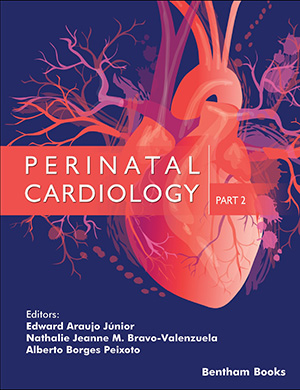Abstract
Congenital heart diseases (CHDs) are largely known as an important cause of fetal perinatal mortality. Currently, the accuracy of fetal echocardiography enables the detailed diagnosis of a significant variety of congenital cardiac anomalies, and it has also been demonstrated that prenatal outcomes may improve in critical CHDs. Accordingly, this chapter provides a detailed overview of the important anatomic aspects of some of the ventricular inflow anomalies, focusing on currently available information, to enable the prenatal diagnosis of such CHDs by ultrasound or echocardiography. Information regarding prenatal management, delivery plan strategies, and differential diagnosis of such anomalies is presented. The chapter also discusses the parental counseling and fetal and neonatal therapeutic management of such congenital cardiac anomalies. Univentricular atrioventricular (AV) connections, straddling and overriding of AV valves, and crisscross hearts are described in the current chapter. The concept of “functionally single ventricle” encompasses a group of CHDs in which the dominant ventricular chamber is responsible for maintaining the systemic and pulmonary circulations and not suitable for a biventricular repair. The central feature of such hearts is the univentricular AV connection. Regarding the type of the straddling of an inlet valve, it is based on the insertion of the tension apparatus of the AV valve into the crest of the ventricular septum or in the contralateral ventricle. Meanwhile, overriding of an inlet valve is related to the annulus of the AV valve and may interfere in the AV connection. Depending on the degree of the overriding of the straddled valve, the ventricles are in a dominant and rudimentary relationship, and a double-inlet AV connection, primarily the double-inlet left ventricle is the most frequent type of AV connection. In general, straddling and overriding of an AV valve requires a ventricular septal defect, and straddling may occur alone or in the presence of an overriding. In “crisscross” hearts, the ventricular inlet flows are in a cross shape and the ventricles are arranged in a superoinferior relationship. During an ultrasound examination, the crossed AV valves produce false images of the mitral valve or tricuspid atresia in a standard 4-chamber view, which makes the diagnosis difficult. In fact, the knowledge about the detailed anatomy, the assessment of the ventricular outflow tracts, and the identification of other possible associated cardiac anomalies are important for improving In Utero and postnatal management in ventricular inlet anomalies described in the current chapter.
Keywords: Cardiac valves, Chordae Tendineae, Congenital heart disease, Crisscross Hearts, Double-inlet ventricle, Echocardiography, Mitral valve, Prenatal diagnosis, Single ventricle, Tricuspid valve, Univentricular heart, Ventricular morphology.






















